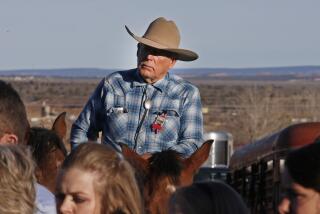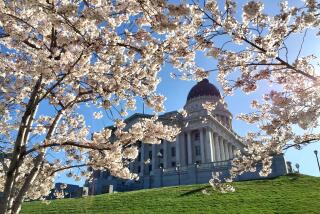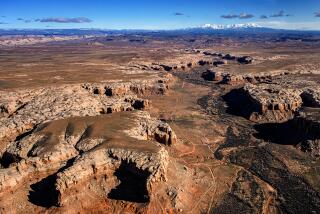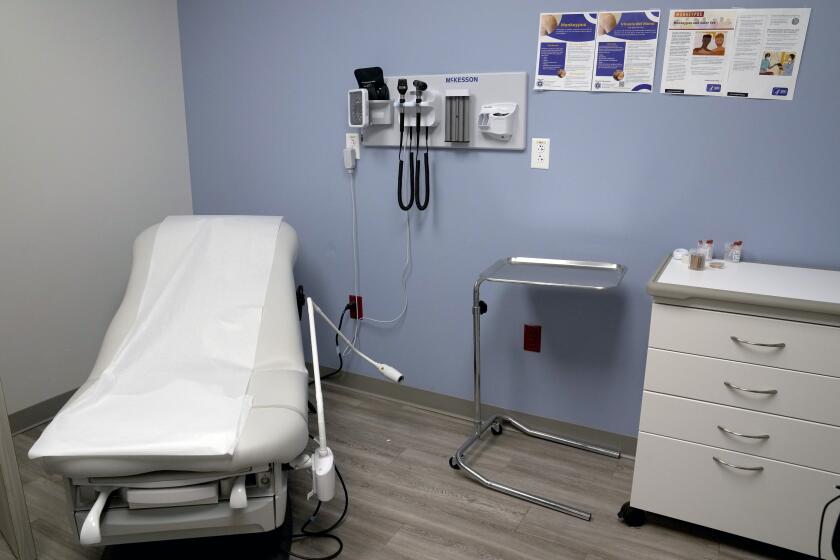Protesters in Utah drive ATVs onto federal land — but find no showdown
The ATVs kicked up sprays of dirt, their riders waving American flags and protest signs as they rumbled along a disputed canyon trail that federal officials had closed to motorized vehicles.
Their message Saturday was clear amid the dust: This was the latest challenge by citizens saying they are defending state and local rights against an increasingly arrogant federal government that has overstepped its role in small communities such as Blanding.
The protagonist this time wasn’t a private rancher like Cliven Bundy, who prevailed in a standoff with the Bureau of Land Management in Nevada. This protest was the brainchild of a public official, San Juan County Commissioner Phil Lyman, who contends that this town of 3,500 residents has tried hard to compromise with the bureau to reopen scenic Recapture Canyon to all-terrain vehicles.
BLM officials banned the vehicles to protect archaeological sites, a move residents say has cheated them out of a prime recreational area. Unlike in the Bundy incident, no guns were brandished here, but the words were volatile. “If you make a rule that I have to lick your boots,” Lyman said of federal officials, “I’m just not going to do that.”
On Saturday, a dozen sheriff’s deputies watched the protest from horseback. BLM officials were not so visible. “They were here, but they didn’t wear their uniforms,” Sheriff Rick Eldredge said. “They didn’t want a clash.”
Antigovernment attitudes in the West have a long and virulent history, and recent public dialogue has remained marked by a threatening tone that prompted past BLM directors to travel with armed security.
More than 50 political leaders from nine states recently convened in Salt Lake City to talk about their joint goal: wresting control of oil-, timber- and mineral-rich lands away from federal officials. Six Western states are studying the feasibility of taking over federal land within their borders.
In Nevada, Bundy’s “range war” with federal officials, supported by armed “citizen soldiers,” resulted in death threats against Sen. Harry Reid (D-Nev.), who called the militia members “domestic terrorists.”
“Each day that goes by, it’s hard for me to comprehend how ugly, vile, vulgar and threatening people are sending letters to my home and making other threats,” Reid recently told reporters.
Last week in rural Utah, two men pointed a handgun at a BLM worker in a marked federal vehicle while holding up a sign that said, “You need to die.”
But even before that, BLM employees in southern Utah seldom wore the agency’s uniform, in an effort to maintain a lower profile. Many longtime BLM agents have adopted the habit of parking their trucks nose-out. “Sometimes we need to get out of a place pretty fast,” one said.
In Utah, some high-profile lawmakers have led the criticism against Washington.
“The federal government has done a pathetic job of reaching out and building local relationships. You can’t just show up with guns blazing and expect to win the hearts and minds of the public,” said Rep. Jason Chaffetz (R-Utah), whose district includes Recapture Canyon.
“Frustration is as bad as I’ve seen it, and it’s getting worse,” he said.
He mentioned that federal Homeland Security officials recently drove an armored tank in a local parade: “People were outraged. The way most see it, they just came in flexing their muscles, showing they had all this armor. The federals need a little more Andy Griffith and a lot less Rambo.”
So Utah, he says, is fighting back.
In rural Kane County, local officials have torn down signs on BLM land and told local bureau managers that they do not recognize U.S. government authority over public land there. Ranchers in the state’s western reaches — supported by local and state officials — have threatened to round up wild horses even though it’s against federal law, saying the herds are crowding out grazing cattle.
Last summer the state Legislature authorized a $3-million fund so there would be ready cash to sue the federal government regarding federal land mandates. It also approved $500,000 to fund a study looking at how the state might wrest control of 30 million acres of public land within Utah.
Former BLM Director Patrick Shea, who led the agency from 1997 to 1999, said the threat of violence always accompanied him on business trips out West. “Whenever I went to southern Utah and some other states, I had security people with me — it wasn’t because of me as an individual but because of the office I headed,” he said.
The situation now, he said, is far worse. He blamed both what he called small-town leaders looking for easy votes and seething citizen militias.
“They’re just roaming bands of loners who want to pretend they’re 19th century cowboys,” he said. “They scare me. If someone gets drunk or angry and decides to use their weapon, then we have bloodshed. And there’s always a loose nut who’s going to show how much testosterone he has.”
San Juan County, where only 8% of the land is not managed by the BLM, has its own bitter history with federal officials. In 2009, doctor James Redd committed suicide after federal officials interrogated him, searched his house and charged him in an investigation into the trafficking of Native American artifacts. His family has since filed a lawsuit.
Rancher Ron Eberling said he expected matters here to eventually turn violent, though he added, “Most of us are not violent people.”
At a rally Saturday before the protest ride, 200 people gathered at a local park, including Aamon Bundy, Cliven Bundy’s son, and several armed supporters. That’s when Lyman surprised everyone, suggesting a drive into the canyon, but not into restricted areas.
Many in the crowd booed. Wielding a pocket-sized Constitution, Bundy said that the land belonged to San Juan County residents and that they had a right to ride it.
One man said: “Rosa Parks didn’t have a case until she sat in the front of the bus.” Another added: “The BLM has guns and mace and Tasers and shackles, but we’ve got guns too!”
Lyman responded: “My grandfather called that canyon the most beautiful thing he’d ever seen in his life. It’s important to our family. To see it as the focal point of a conflict is painful.”
Then he headed off atop his ATV to recapture the canyon.
Times staff writer Julie Cart in Los Angeles contributed to this report.
More to Read
Start your day right
Sign up for Essential California for news, features and recommendations from the L.A. Times and beyond in your inbox six days a week.
You may occasionally receive promotional content from the Los Angeles Times.






